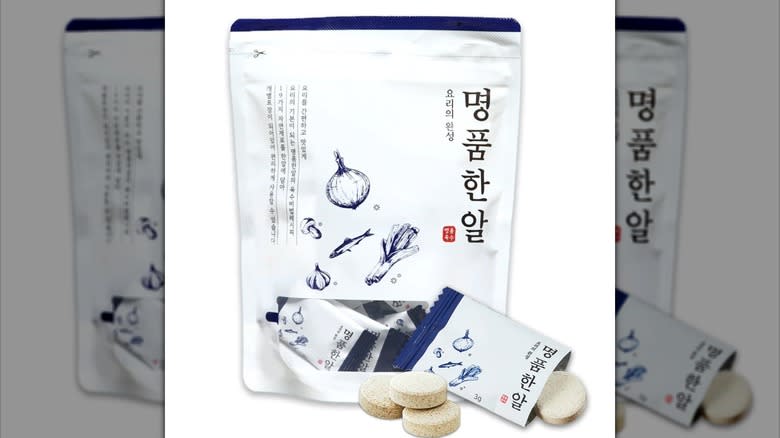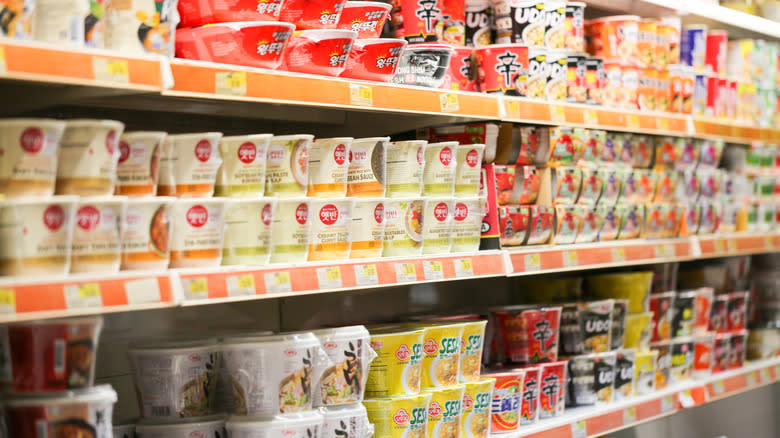Anchovy Broth Tablets Are The Fishy Stock Enhancers Your Pantry Is Missing

We may receive a commission on purchases made from links.
You've probably heard of bouillon cubes, but usually in meaty varieties like chicken or beef, or perhaps even vegetable. Some soups, however, call for a more delicate umami flavor. That's when you need anchovy broth tablets. These can impart umami and that distinct "fresh from the sea" flavor that fish sauce just can't achieve on its own. Fish broths — and anchovy broths, in particular — are underutilized in Western cuisine, perhaps in part because the homemade version can be tedious to make and isn't a part of the average home cook's repertoire. But with the help of anchovy broth tablets, anyone can infuse their cooking with a bit of subtle, fishy, umami flavor.
You may be more familiar with generic fish stock, or perhaps the Japanese equivalent, dashi broth, which is made from dried tuna flakes (bonito). Anchovy broth and its more modern tablet form are common in Korean dishes such as kimchi jjigae, doenjang jjigae, and bugeoguk, but they can also be used in many Western recipes such as bouillabaisse or clam chowder. Basically, just add one of these tablets to anything you want to have a light but high-impact fish flavor.
Read more: 12 Little-Known Facts About Salt
What Are Anchovy Broth Tablets?

Anchovy broth tablets and bouillon cubes are very similar, as both and contain dried bits of protein from actual anchovies; however, bouillon cubes also have a few other ingredients to enhance their flavor, namely vegetables like onions, daikon radishes, garlic, cabbage, mushrooms, and lotus root. You may also find other fishy components included, like squid, clam, or oyster extract, which further enhance their lightly fishy flavors. These tablets are designed to take the fussiness out of making a balanced, traditional anchovy broth, like that found in Korean cuisine known as myeolchi-yuksu.
Some bouillon cubes are made from evaporated stock, in which the protein, usually beef or chicken, is boiled, evaporated, then dried and powdered. In the case of anchovy broth tablets, however, the ingredients are usually dried whole, powdered, and then pressed into a tablet or cube. That's likely because fish, unlike beef or chicken, don't need to be cooked in advance for their flavors to be extracted and their fat and protein rendered. When they come in contact with liquid, the ingredients are rehydrated, and the flavors and fragrances will bloom.
Anchovy Tablets Versus Fresh Anchovy Broth

Anchovy tablets are made with freeze-dried anchovies, vegetables, and other powdered extracts. Once these tablets come into contact with water or another liquid, they dissolve and their ingredients are rehydrated. Fresh anchovy broth recipes also call for dried anchovies; these are added to hot water, then removed and discarded after soaking for a time. Of course, the tablets contain more than just anchovies, and most freshly made broths require more than just fish. They usually involve dried kelp at minimum, but it's also common to add fresh garlic, radishes, and onions. At a glance, anchovy broth tablets have a fairly similar ingredient list to their fresher counterpart.
Fresh anchovy broth does have one distinct disadvantage, however: Dried anchovies are dried whole, which means they include the guts and heads. It might be tempting to toss the fish in all at once, but the guts and head are known to make the broth bitter. This means you'll need to gut and remove each fish head. If you've seen how small anchovies are, you can probably guess this is a super tedious task. The tablets eliminate this step and deliver super similar results. The other key difference is that the tablets are shelf-stable and can last for a long time, while the fresh veggies used for a stock will not.
What Do Anchovy Broth Tablets Taste Like?

It's important to remember that anchovy broth tablets are concentrated forms of stock, so their flavor and smell are quite pungent on their own. Don't let this overwhelm you, though — you'll be diluting them in water or another medium. As you can probably imagine, these tablets have a fishy flavor, thanks to their pulverized anchovies and other seafood extracts. They do, however, also have some other pronounced taste notes thanks to the addition of vegetables. Leek, garlic, onion, and scallions are all used in the tablets, so there should be no shortage of lightly spicy, sweet, and aromatic alliums in your anchovy broth. Ginger, lotus root, and pepper also lend a warm earthiness to the tablets.
The most common term you'll probably hear about the flavor of anchovy broth is "umami," which is often used as a catch-all term for savory or meaty flavors. Umami is hard to pin down because it's usually more subtle than sweetness, tartness, bitterness, and so on. But anchovy broth tablets provide a very delicate umami flavor that's deeply satisfying and hearty.
How To Cook With Anchovy Broth Tablets

Undoubtedly, the most common scenario in which you'll see anchovy broth tablets is dissolving them in water to make — what else? — anchovy broth. This can serve as the base for soups and stews, again, usually from Korean cuisines like kimchi and soybean stew. However, these tablets can add a kick of umami and flavor to many different dishes, such as fruits de mer pasta, bouillabaisse, or poached fish.
Any home chef can simply dissolve one of these tablets into the cooking water or fat and let it mingle with the other ingredients. These handy tablets are also great for simple weeknight meals; anyone can add one to their rice or ramen on the stovetop. If a shrimp stir-fry is on the menu, the chef can simply dissolve a tablet into just a bit of water and then use it to deglaze the pan, picking up each flavorful bit while adding moisture and complex flavors to the dish.
Where To Buy Anchovy Broth Tablets

While these tablets may become more common in mainstream grocery stores in the soup and stock aisles as time goes on, your best bet is in Korean or pan-Asian markets such as H-Mart. These shops are found outside of many Chinese and Korean districts in major cities; many are located in the suburbs, though, so you may need to take a drive to find one. Because these tablets are primarily used in soups and stews, check for them in the soup aisle. Although these stores are probably your surest bet, not everyone has access to them. Fortunately, you do have other options. As of March 2023, some Costco shoppers reported seeing anchovy broth tablets at their local big-box store. at their local Costco.
Anchovy broth tablets may not be ubiquitous just yet, but if you don't have a local Asian market to visit, you have some options online, thanks to small business food vendors who specialize in food items from numerous cuisines across the Asian continent. Gochujar Global is one of these; it offers a 40-pack of tablets for about $40, or roughly $1 per tablet. Amazon seemingly sold some anchovy broth tablets through its marketplace at some point, but inventory seems shaky, so you may need to monitor a few listings to see when they become available again.
Nutritional Information For Anchovy Broth Tablets

Most anchovy broth tablets are made in Korea and thus are subject to various laws regarding ingredient lists and nutritional labels; as such, nutrition information for each brand may vary. Kim's Table, one anchovy broth tablet seller, reports just 20 calories per three tablets; similarly, a serving of fresh Korean anchovy soup stock contains just 39 calories with 10 grams of carbs and 1 gram of protein.
In addition to plenty of dried veggies and other seafood ingredients, salt is often present in anchovy cubes, as well. This enhances the ingredients' flavor and simplifies the broth-making process, but dishes calling for additional salt or soy sauce may need adjustments, especially if you're sensitive to salt. On the subject of flavor enhancers, some anchovy broth tablet brands boast that their recipes don't include monosodium glutamate (MSG), though others do contain this controversial ingredient. MSG is present in many popular chicken and beef broth cubes (such as Knorr) and is a naturally occurring substance in kelp, another key ingredient in anchovy broth tablets, so it shouldn't raise too many alarm bells here.
Read the original article on Mashed.

